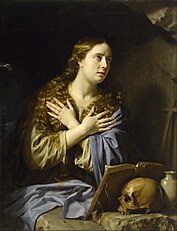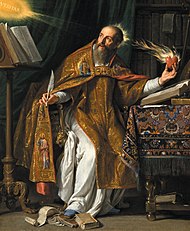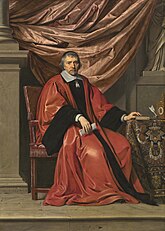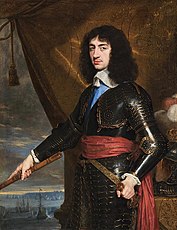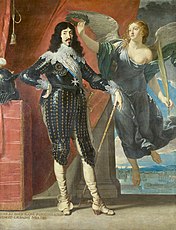Philippe de Champaigne
Philippe de Champaigne | |
|---|---|
France | |
| Known for | Painting |
| Movement | Baroque |
Philippe de Champaigne (French pronunciation: [ʃɑ̃paɲ]; 26 May 1602 – 12 August 1674) was a Brabançon-born French[1] Baroque era painter, a major exponent of the French school. He was a founding member of the Académie royale de peinture et de sculpture in Paris, the premier art institution in the Kingdom of France in the eighteenth century.
Life and work
Born of a poor family in

It was only after he received news of Duchesne's death that he returned to marry his daughter.
This site was destroyed during the French Revolution, but there are several paintings now preserved in museums, that were part of the original design. The Presentation in the Temple is in Dijon, the Resurrection of Lazarus is in Grenoble and the Assumption of the Virgin is in the Louvre.
He also worked for
Career
Champaigne produced a very large number of paintings, mainly religious works and portraits. Influenced by Rubens at the beginning of his career, his style later became more austere. Philippe de Champaigne remains an exceptional painter thanks to the brilliance of the colors in his paintings and the stern strength of his compositions.[3]
He portrayed the entire French court, the French high nobility, royalty, high members of the church and the state, parliamentarians and architects, and other notable people. His portrait of the poet Vincent Voiture was created around 1649 as the frontispiece for Voiture's published Works (published posthumously in 1650). The portrait is highly unusual in that Champaigne later reworked it as a portrait of a religious figure, Saint Louis (King Louis IX), to enable Voiture's daughter to keep it with her when she entered a convent.[4]
In depicting their faces, he refused to show a transitory expression, instead capturing the psychological essence of the person.[5][6]
His works can be seen in public buildings, private collections, churches such as Val-de-Grâce, Sorbonne, Saint Severin, Saint-Merri, Saint-Médard and in the Basilica of Notre-Dame du Port in Clermont-Ferrand.
Champaigne was prominent enough in his time as to be mentioned in Cyrano de Bergerac in a line by Ragueneau referencing Cyrano: "Truly, I should not look to find his portrait By the grave hand of Philippe de Champagne."
His pupils were his nephew Jean Baptiste de Champaigne, William Faithorne, Jean Morin, and Nicolas de Plattemontagne.[7] During his last period Champaigne painted mainly religious subjects and family members.[8] He died in Paris in 1674.
Gallery
- Selected works
-
The Annunciation, c. 1645, Wallace Collection
-
The Annunciation, c. 1636, located in the Saint-Jean-Baptiste de Montrésor Church
-
The Repentant Magdalen, 1648
-
Le sacrifice d'Isaac
-
Moses with the Ten Commandments
-
Ecce Homo
-
The Dream of Saint Joseph, 1642–43, National Gallery, London
-
Saint Augustin, 1645–1650
-
Saint Paul
- Portraits
-
Portrait of Arnauld d'Andilly, 1650, Louvre
-
Louis XIII of France in Coronation Robes, c. 1622–1639, Royal Collection
-
National Gallery, London
-
Portrait of Jean-Baptiste Colbert, 1666
-
Reverend Father Giovanni Antonio Philippini, 1651, Museum of Fine Arts, Boston (1993.35)
-
Portrait of Omer Talon, 1649
-
Charles II of England, 1653
-
Double portrait ofFrançois Mansard and Claude Perrault, 17th century, attributed
-
Louis XIII Crowned by Victory, 1635, Louvre
References
- ^ Philippe de Champaigne, at larousse.fr
- Digital library for Dutch literature
- ^ "Getty Artists Philippe de Champaigne". getty.edu.
- S2CID 191341600.
- ^ "Philippe-de-Champaigne [His strongest works are the natural and lifelike psychological portraits]". global.britannica.com.
- ^ "Hyacinthe Rigaud. Philippe de Champaigne. Portraits" (PDF). google.se. Archived from the original (PDF) on 3 March 2016. Retrieved 12 October 2014.
- RKD
- ^ "Getty Artists Philippe de Champaigne". getty.edu.
External links
![]() Media related to Philippe de Champaigne at Wikimedia Commons
Media related to Philippe de Champaigne at Wikimedia Commons
- PhilippeDeChampaigne.org, 98 works by Philippe de Champaigne
- ScholarsResource.com, Paintings of Philippe de Champaigne



